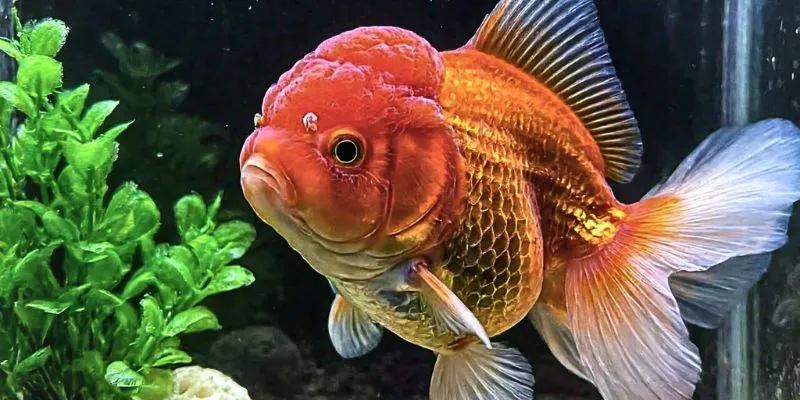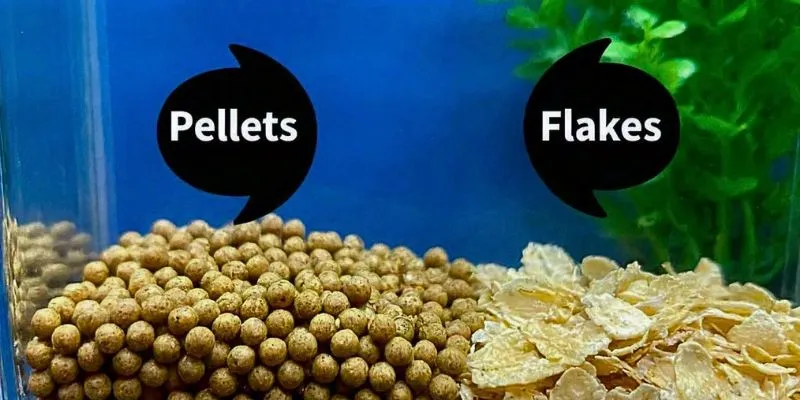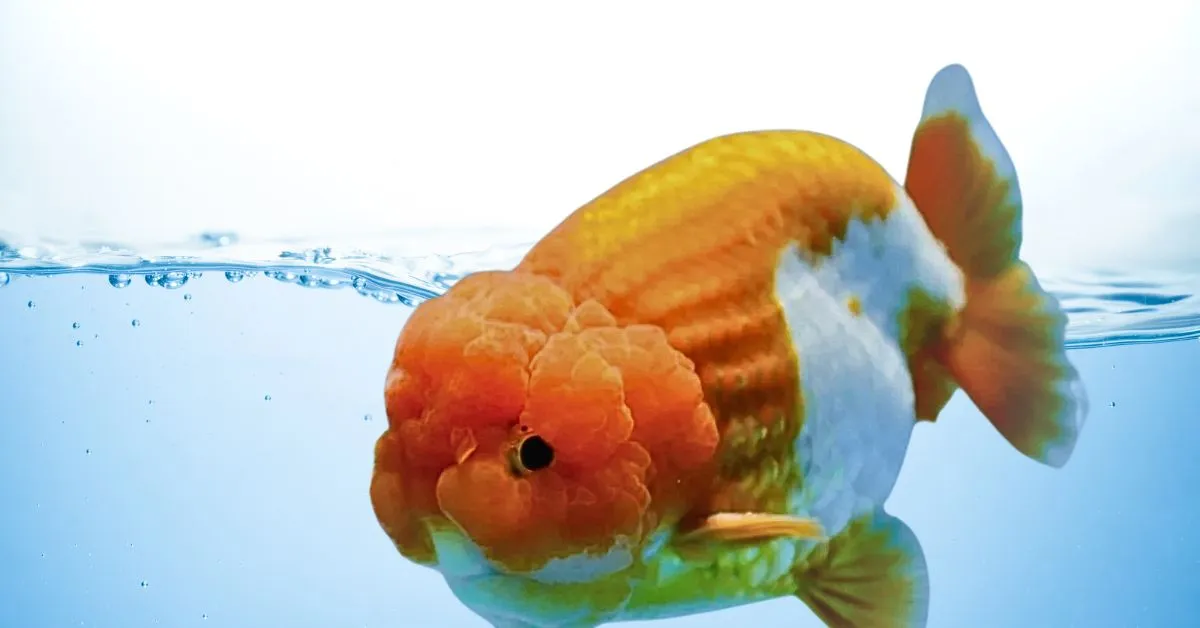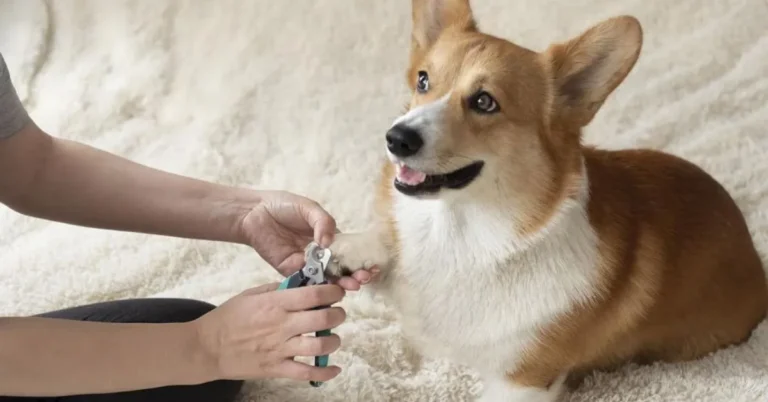Lionchu Goldfish
The Lionchu Goldfish is unique among these fish because it is a hybrid of two different species. His parents are the lion head goldfish and the Rancho, a breed known as the king of goldfish. Both types have long been popular with hobbyists, although the first is Chinese and the second is Japanese. The lionchu goldfish is a relatively new species, first bred in Thailand and first exhibited in 2006.
There are many similarities between the generations of these two parents, including many of their enthusiasts. When these two species are mixed, they enhance their attractive characteristics to create a unique fish.
The physical appearance of Lionchu Goldfish:
They have a ‘bubbly knobbly’ hood that gives them a swollen or ‘bee stung’ look. The flesh around their eyes can make them look a little “sleepy”. Lionchu lacks a dorsal fin like their parent species, making them slow-swimming fish. They have a double tail that resembles both parent species.
The most common color combination of lionchu goldfish is orange/red and white, although occasionally they are seen in black, yellow, blue, calico, or a combination of three colors. Their color distribution varies, some fish are almost the same color with a small spot of white, while some fish are mostly white except for the color of the head.

Do These Fish Make Good Pets?
Not only is it famous for its appearance but for being a friendly and intelligent lionchu goldfish has become a good pet fish. These fish are capable of forming memories and can make associations between specific activities and rewards. As the fish gets comfortable in its new environment, you can train it to take food from your hand. After all, rewards are a powerful motivator for fish, too.
There are no complaints about falling in love with a lionchu goldfish. This fish looks very cute and almost like a toy fish thanks to the fleshy coil or vane on its head. This trait has been further enhanced by selective breeding, which has made this fish even more attractive. This is the reason why the popularity of parent breeds and lionchu goldfish has increased.
How to Take Care of Lionchu Goldfish Habitat, Tank Conditions & Setup:
Taking care of a Lionchu goldfish requires time and attention to create the ideal environment for them to thrive. As a sensitive breed, Lionchus have specific needs that must be met.
Aquarium Size
The size of the tank depends on the number of Lionchus you have. For a single Lionchu, a twenty -gallon tank is the minimum you should live for. For two, go for at least 30 gallons. If you plan on keeping a community of Lionchus, a 50-gallon tank or larger is recommended. Lionchus are not suitable for smaller tanks.
Substrate
The soft and smooth substrate is best for lionchu fish because they are sensitive. Smooth, metal-free concrete or gravel is ideal. Avoid rough substrate or small pieces of substrate that they can swallow. Carole must be vacuumed every 2 weeks to keep the tank clean.
Plants
Although plants are not essential, adding them to the tank can be beneficial. These lionchu give fish something to chew on, and since they are face-to-face fish, they like a varied diet.
Lighting
Lionchu goldfish aren’t particularly picky about lighting. They do well in high and low light. They are usually more active during the day when the lights are on and calm down when the lights are dimmed.
Filtration
A high-quality filter system is essential for a lionchu fish tank because these fish produce a lot of waste. Because of their sensitivity, they need clean water. The water current should be kept low. It’s best to use an adjustable filter so that the water flow doesn’t hit the Lionchu swimming area directly, as they are slow swimmers and can struggle with strong currents.
Diet and feeding method:
Goldfish, including the lionchu type, have amniotic feeding habits, meaning they eat both meat and plants, including algae. You can easily replicate this natural diet for your captive fish by adding fancy goldfish flakes or pellets and some frozen meaty foods to the daily diet.
A good staple diet for lionchu goldfish may include:
- Fancy goldfish pellets and flakes
- Frozen meaty foods such as brake shrimp, bloodworms, mosquito larvae, tubifex worms, etc
- Fresh vegetables, such as shelled peas, zucchini, etc

Do Lionchu Goldfish Like Live Foods?
Lionchu goldfish love live food because it is similar to their natural diet. However, feeding live food to fish is not considered appropriate. Although they are nutritious, live food often contains hidden bacteria and parasites that can be dangerous to fish. Instead, feed your lionchu fish with frozen meat. They give you the same benefits of live food without the risks.
Reproduction of Lionchu Goldfish:
If you are interested in breeding lionchu goldfish, follow these steps:
- Tank Preparation for Breeding: First, you need to prepare a breeding tank. Use spawning mops or fine-leafed plants to give female fish a suitable place to lay their eggs.
- Add the Pair: Now add the male and healthy female lionchu goldfish to the tank. Watch for courtship behaviors such as running or pushing each other during this time. The female lays eggs and the male fertilizes the eggs at this time.
- Removing Adults: Once breeding is over, get rid of adults as soon as possible and take them to a conducive place so that they can’t eat fertilized eggs.
- TAKE CARE OF THE EGGS: Now transfer these fertilized eggs to a separate tank. Make sure the tank has adequate aeration and water circulation, and that the water conditions are correct for at least 24 hours before the eggs hatch.
- Hatching and Juvenile Development: When eggs hatch, provide adequate food and monitor water conditions closely. Correct water conditions are very important for the survival and development of children.
Common diseases and prevention:
White spot disease
Symptoms: white spots on body, gills, and fins; Rubbing of fish with objects.
Treatment: Use anti-itch medication, accelerate the life cycle of the parasites by raising the water temperature, and do water changes to remove the parasites
Fin Rot (Decomposition of Feathers)
Symptoms: Cracked and cracked feathers, often with discolored or whitish edges.
Treatment: Use antibacterial medication from a pet store, and maintain good water quality to prevent further infection. Regular water changes and removing decayed material from the tank can help.
Bacterial Infection
Symptoms: red spots, blisters, missing feathers, lethargy, or loss of appetite.
Treatment: Use a broad-spectrum antibiotic treatment from a pet store, and keep water conditions ideal. If necessary, move any injured or stressed fish to a quarantine tank.
Prevention:
- It’s important to perform regular water changes (30% per week) to keep water quality.
- Water must be filtered and oxygenated enough to stay clean.
- New fish often need quarantine for at least two weeks before moving to the main tank.
- Never overfeed in order not to contaminate water and suffer from digestive problems.
Lionchu Goldfish Price Estimate:
- Juvenile Lionchu Goldfish: $10 – $40
- Adult Lionchu Goldfish: $40 – $150
- Rare Color Variants: $150 – $500 (or more, depending on rarity and demand)
Conclusion:
The lionchu goldfish is unique among these fish because it is a hybrid of two different species. His parents are the lion head goldfish and the Rancho, a breed known as the king of goldfish. They have a ‘bubbly knobbly’ hood that gives them a swollen or ‘bee stung’ look. Not only is it famous for its appearance but for being a friendly and intelligent lionchu goldfish has become a good pet fish. There are no complaints about falling in love with a lionchu goldfish. This fish looks very cute and almost like a toy fish thanks to the fleshy coil or vane on its head.







